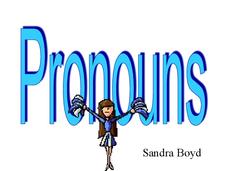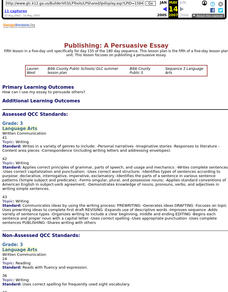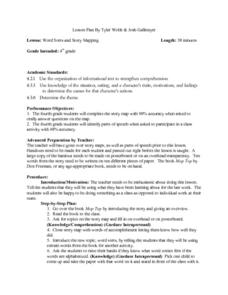Curated OER
Wacky Web Tales
Students study the parts of speech and then review them. They identify each part of speech and place them on a tree map. Then they visit a website to create a "Wacky Web Tale" using information from the tree map. They print their tales...
Curated OER
Prefixes, Un-, Re-, and, Dis-
Third graders identify prefixes and use prefixes correctly in sentences. They edit and change sentences containing prefixes.
Curated OER
Fun With Formatting
Students investigate the concept of using a word processing program with the intention of improving formatting skills like centering text. They also highlight different text sections and demonstrate how to save changes made to a document...
Curated OER
Pronouns
Subject, object personal. Possessive, reflexive, indefinite. Everything you want to know about pronouns and their antecedents is contained in a colorful 32-slide presentation.
Curated OER
Using Intensive Pronouns
Myself, yourself, and himself are intensive pronouns. Get your learners using these pronouns when writing sentences with this series of worksheets which include a reading and discussion section, examples, three practice activities, and...
Curated OER
History of English
Providing both a history of English before England (Sino-Tibetan, Finno-Ugric, Hamido-Semitic, Indo-European) and a history of English in England, this presentation includes charts and many examples of the changes in the English language...
Curated OER
Using Is/Are in Sentences
In this interactive grammar worksheet, students choose either the word "is" or "are" from the drop down menu to complete each of the ten given sentences.
Curated OER
Pronouns and Possessive Adjectives
In this pronouns and possessive adjectives worksheet, students identify usage in sentences. In this short answer worksheet, students write sixteen answers.
Curated OER
Grammatical Person: 1st, 2nd, and 3rd Person
In this grammatical person: first, second, and third person worksheet, students determine the speaker/participants relationship. Students use a chart to identify grammatical person in seventeen sentences.
Curated OER
Few and Less: A Confusing Pair
In this grammar instructional activity, learners learn the difference between the words "few" and "less" as well as adverbs and adjectives. They then answer the 14 questions on the page by inserting either few/fewer or less in the blank.
Curated OER
Publishing: A Persuasive Essay
Third graders are given an opportunity to create a visual to accompany their presentations of their persuasive essays. They may use the computer or other media as resources.
Curated OER
Word Sorts And Story Mapping
Fourth graders engage in a activity that covers the concept of using a storymap to increase reading comprehension. They possess the prior knowledge of parts of speech from previous lessons. Students fill in the blank storymap while...
Curated OER
Pronouns
Ninth graders define the term 'pronoun', differentiate between personal, possessive, interrogative, indefinite and demonstrative pronouns, and identify the eight parts of speech.
Curated OER
Whose Voice Do I Hear?
Fifth graders examine the power of voice in writing by completing a story using words following a particular voice. They take simple nursery rhymes, then attempt to put their own voice to a revised version. An interesting instructional...
Curated OER
Reflected: Using Reflexive pronouns
For this grammar worksheet, learners learn about reflexive pronouns in sentence writing. They then use what they read to answer the 7 questions on the page. The answers are located on the last page of the packet.
















